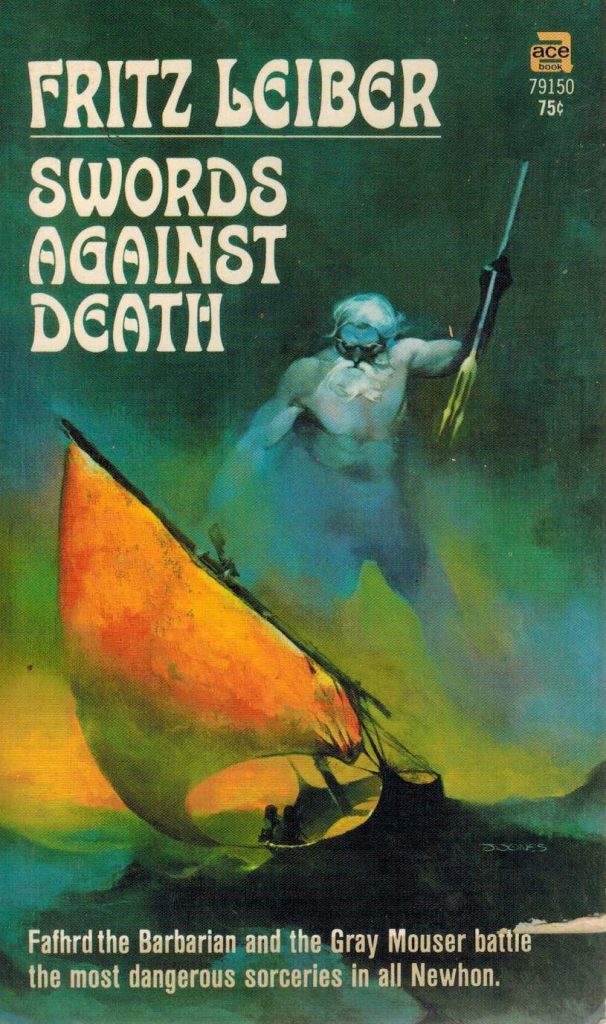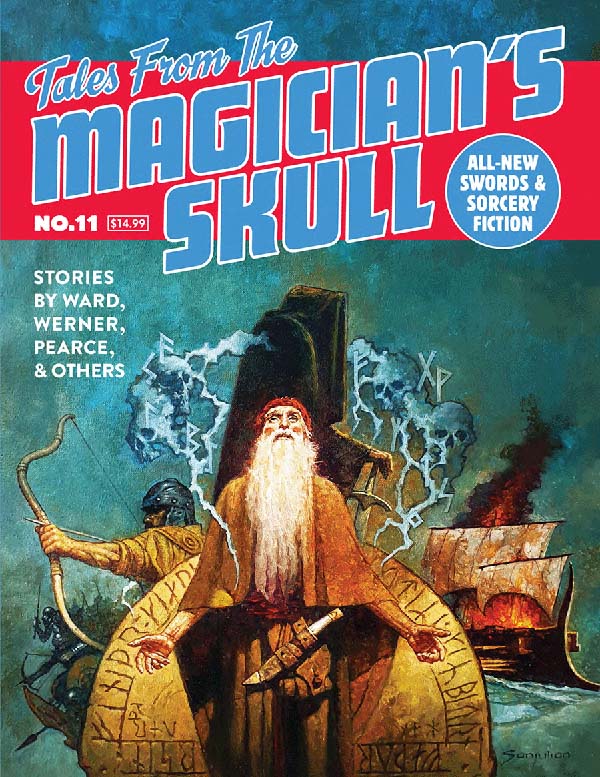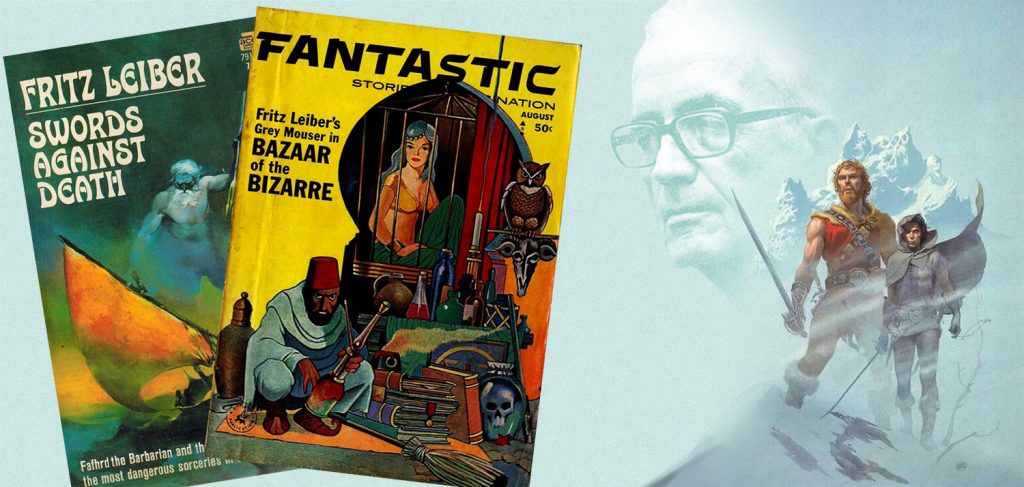
The Monsters and Magic of Lankhmar Indiegogo campaign is currently live over on Indiegogo, and what better way to help celebrate it than to take a look at the world from which they originate? Enjoy!
Short Sorcery: Fritz Leiber’s “Bazaar of the Bizarre”
by Bill Ward
If I had to describe Fritz Leiber’s Fafhrd and the Gray Mouser stories in one word, that word would be ‘fun.’ Not the dismissive ‘fun’ often given as a back-handed compliment to fiction that doesn’t rise above the level of the merely entertaining, but visceral, in the bones, unexpected-snow-day-can’t-wipe-that-smile-from-your-face kind of fun. Perhaps this is due to Leiber’s ironically detached and playfully inventive narrative, or his endlessly creative imaginative near-absurdities, or maybe it’s really because, even in the face of weird peril and horrific oddities, the lovable rogues of Lankhmar themselves are simply out to have fun.
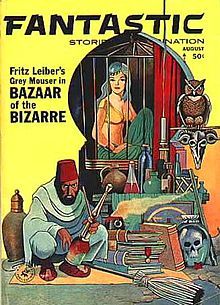
“Bazaar of the Bizarre,” first published in the August 1963 issue of Fantastic but more readily available in the collection Swords Against Death, is certainly in the running for most quintessential Fafhrd and the Gray Mouser story. This isn’t because of the plot. “Bazaar of the Bizarre” borders on being a vignette, and the action of the story could simply be described as the Mouser entering a sinister storefront and falling prey to its magical inducements until Fafhrd, aided by potent artifacts, rescues him. But this simplicity of plot only enables the other elements of the tale to stand out all the more, producing a concise and efficient story in which characterization, theme, and details both colorful and strange are woven together like a complex tapestry – indeed, like something that might be seen hanging up for sale in its titular storefront.
“The strange stars of the World of Nehwon glinted thickly above the black-roofed city of Lankhmar, where swords clink almost as often as coins.” As an opener, this line is a model of concision, but it not only sets the scene, but launches the extended cosmic metaphor that underlies the entire story. The following paragraphs that describe Plaza of Dark Delights follow suit, piling contrasting images of light and darkness one upon another, over and over again, describing a place where “shop-lights glinted upward no more brightly than the the stars glinted down” as merchants and vendors huddle around “foxfire, glowworms, and firepots” and “conduct their business almost as silently as the stars conduct theirs.” Even the message Fafhrd receives from his supernatural mentor is part of this underlying theme, a pore-pricked square of serpent hide that, when held before the fire makes a pattern of stars spelling out a cryptic summons.
And the star field theme, the black infinite night, is part and parcel of what is going on in the story. Both of our Lankhmarian rogues have been sent to the plaza by their patrons, but the perennially-incapable-of-following-instructions Gray Mouser arrives first, and decides to investigate the brightly lit new store front on his own, the description of which suddenly adds a celestial body to our extended night sky metaphor “…like some monstrous moon a-shine with the ray of a murderous sun, the new doorway dimmed almost to extinction the stars of the other merchants of mystery.” And this, of course, is a hint as to what is going on – this novel vendor is actually an outpost of the Devourers, who will not only eclipse all other sellers with their fabulous wares at giveaway prices but who, in fact, seek to dim the light of all other worlds, all other existences, in a massive inter-dimensional trade war that extracts every sliver of value from its target and leaves only rubbish in exchange.
The Mouser’s shopping trip is a delightful assemblage of bizarre and colorful items – one can imagine Gary Gygax taking frequent notes here – but it is also a sardonic reflection of his own character. The Devourers, masters of the grand sorcery of consumerism, only sell trash clothed in the form of an illusion – the projected imagination of the observer. Poor Mouser, most potent of all imaginers, sees unique ancient texts of unknown origin and weird manuals instructing in arts of war and the arts of love, strange contrivances of remote spying, and beautiful, willing courtesans of exotic mien. He is like a kitten in a canary shop and, while still affecting an air of superior disinterest in the marvels that have set his head a-spinning, he unsuspectingly consumes a drugged repast and in nearly wholly absorbed by the bazaar’s diamond-studded, black back wall – yet another star field, one selling the Mouser the ultimate illusion of personal perfection.
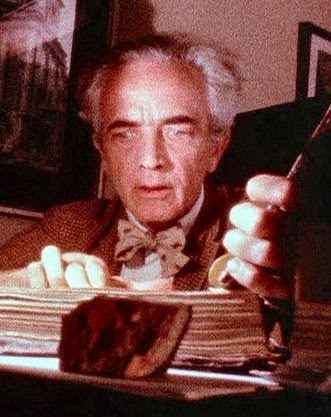
But Fafhrd, equipped with an invisible cloak of invisibility and a paradoxically named Blindfold of True Seeing – both on loan from the witch-potent duo of Sheelba and Ninguable, the twain’s sorcerous patrons – saves the Mouser from cosmic absorption, and clashes in a duel with the shop’s clerk, a broom-armed old man who is, in reality, a sword swinging statue of iron. It is a heroic fight rendered ridiculous through the Mouser’s lying eyes, fell and funny in equal parts. But the twain prevails, and the guardian statue along with the Bazaar of the Bizarre of the Devourers is defeated, both winking out of existence and leaving only “…the sky and the stars and the blank wall” behind.
“Bazaar of the Bizarre” is a tightly woven tapestry of mood and metaphor, creativity and characterization. It eschews the plot-driven narrative of pulp adventure in favor of an imagistically intense romp that is equal parts silly send-up and supernatural suspense. It’s some of Leiber’s best work, and it kicks off so many wild sparks that it’s tempting to mistake it for a constellation all its own – but of course, it’s really just a potent, pleasurable illusion, summoned forth by one of the genre’s master magicians.


